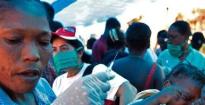Cholera Epidemic Worsens in Haiti
 The New York Times reports:
The New York Times reports:
MEXICO CITY — The death toll in Haiti’s cholera epidemic has reached more than 900, the government reported Sunday, as aid groups rushed soap and clean water to a disaster-wracked population to fight the disease.
The Ministry of Health reported that as of Friday, there had been 917 deaths and more than 14,600 were hospitalized with cholera-like symptoms. That is up from the 724 deaths and 11,125 hospitalizations reported a few days before.
The disease has been found in 6 of Haiti’s 10 provinces, known as departments, and is most severe where it originated, in Artibonite, which accounts for nearly two-thirds of the deaths.
Several epidemiologists have said the disease has not peaked and will likely worsen and break out in other regions of the country, with United Nations health officials estimating about 270,000 may be sickened in the coming years. Several new cholera treatment centers are springing up in the capital and other areas.
“The trend is increasing and it is propagating from department to department,” Roc Magloire, the Ministry of Health’s epidemiologist, said in a telephone interview on Sunday. He referred questions to the ministry’s director general, Gabriel Timothee, who could not be reached.
Hospitals in Port-au-Prince, where more than one million earthquake refugees live in congested, squalid tent encampments, are overflowing with patients exhibiting cholera symptoms, and the death toll there has reached 27. The disease was first reported in the capital on Nov. 8.
President René Préval, at a conference on the disease on Sunday in Port-au-Prince, urged people to wash their hands frequently and drink only potable water, The Associated Press reported. But even before the earthquake, most of the population lacked access to clean water and sanitation.
Cholera, a bacteria that thrives in feces-contaminated water, causes severe diarrhea and vomiting that can dehydrate and kill its victims in hours without treatment. The rate of severe cases, about 30 to 40 percent, is far higher in Haiti than the 25 percent in a typical outbreak because of extreme poverty, unsanitary conditions and the fact that cholera has not been there for 40 years.

